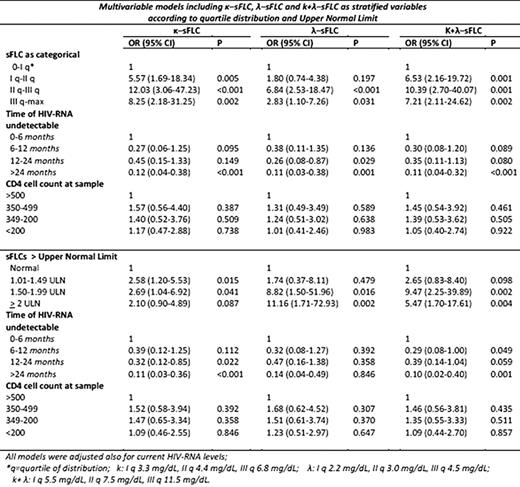Abstract
Abstract 3089
In the last years great interest has been devolved to evaluate the role of B-cell dysfunction in the etiology of AIDS-related Non-Hodgkin Lymphoma (NHL) by directly measuring serum-based markers of B-cell stimulation. Serum free light chains (sFLC) has been proposed as sensitive markers of AIDS-related NHL. Role of sFLC in HL in HIV-infected people has not been completely assessed, and the influence of cART on this marker remains unknown. We evaluated the prognostic value of sFLC to predict the risk of AIDS-related NHL and HD in HIV-infected patients.
The design was a case-control study nested within ICONA. Of 6500 participants enrolled from 1997 to 2007, 86 patients with incident lymphoma were proposed as cases. Information on cancers was obtained prospectively by using medical record review. 46 of 86 patients with lymphoma (NHL =30; HD=16) were included as cases (n=46) because they had no other co-morbidity and a plasma sample available stored before diagnosis of lymphoma. A total of 138 sample-cases were matched 1:1 to lymphoma-free sample-controls (matching for sex, age, distance from diagnosis/selection stratified as 0–2, 2–5, and >5 years). All samples were assessed for quantitative levels of sFLC. Serum or plasma samples stored at -80C were analyzed for quantitative levels of κ and λ sFLC in the Chemistry Laboratory of INMI “L. Spallanzani” in Rome. sFCL concentrations were determined by using the quantitative FLC assay (Freelite; The Binding Site, Birmingham, UK) performed on a Dare-Behring BNII Nephelometer. The assay separately measures κ sFLC (normal range, 0.37 to 1.94 mg/dl) and λ sFLC (normal range, 0.57 to 2.63 mg/dl). A conditional logistic regression was used to identify predictors of lymphoma.
The κ and λ and κ+λ sFLC values were significantly higher in patient with lymphoma than in controls (p=0.008, 0.002, 0.003 respectively). In multivariate analysis sFLC strongly predicted the risk of lymphoma in a dose dependent manner, independently from CD4 count and effective therapy. Longer duration with a suppressed viremia was independently associated with a lower risk of lymphoma. Same results were found for the subgroup of subjects with HD and that with NHD.
Elevated sFLC was a strong and sensitive marker of risk of development of NHL and HD in HIV-infected individuals. Decreasing lymphoma risk was independently associated with increasing cumulative time spent with HIV viremia < 400 cp/ml. This could reflect the detrimental effects on immune status associated with absence of treatment or incompletely effective HAART or other disturbances of immune function such as chronic immune activation and the direct effects of HIV on B-cells. Subjects with sFLC >50% of normal threshold at most recent samples (0-3 years) showed an increased risk of lymphoma than subjects with the same levels of sFLC at an earlier sample. Our results seems indicate a weak association between elevated sFLC and risk of death/relapse among subjects with lymphomas.
No relevant conflicts of interest to declare.
Author notes
Asterisk with author names denotes non-ASH members.


This feature is available to Subscribers Only
Sign In or Create an Account Close Modal